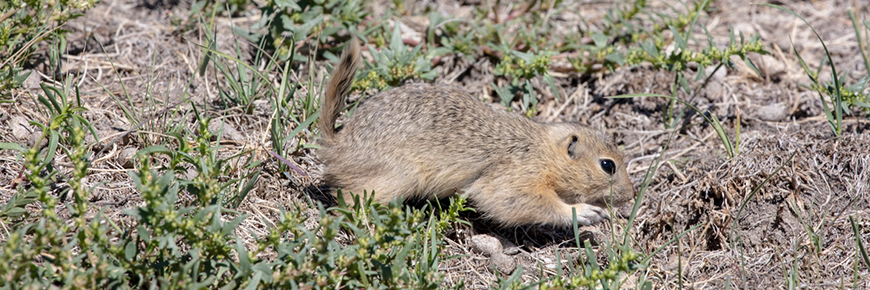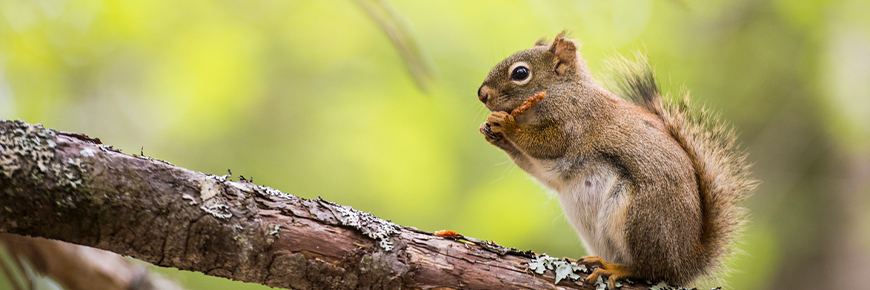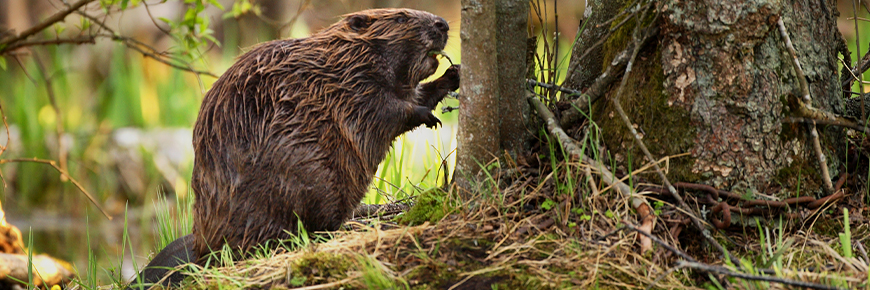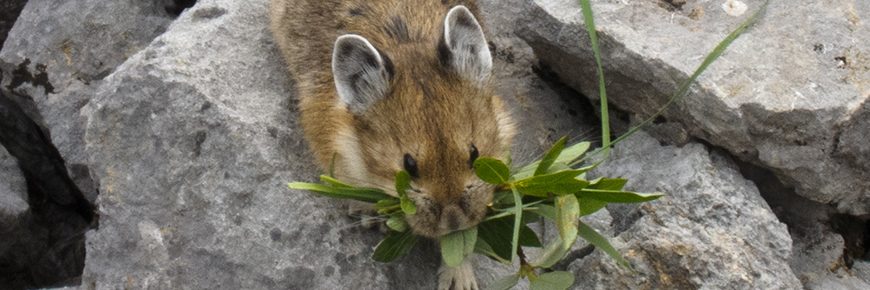
Small mammals in Banff National Park
There are about 40 species of small mammals in Banff. They range in size from the pygmy shrew, which weighs only a few grams, to the beaver, which can weigh up to 20 kilograms. Except for shrews, bats, weasels, martins, minks and rabbits, these animals are all rodents.
Columbian Ground Squirrel - Spermophilus columbianus

The Columbian Ground Squirrel is the most commonly seen animal in the park during the summer. Although they hibernate for up to seven months, they are a valuable prey species for grizzly bears, coyotes, wolves and golden eagles. A winter hibernator, this ground squirrel may be seen throughout the park from the montane valleys to the alpine.
Characteristics: Tan-coloured. Longer body. Has a high pitched “squeak”.
Hoary Marmot - Marmota caligata

Hoary Marmots are colonial animals that live in the alpine zone from 6,800 to 8,000 feet. They are one of the largest rodents in the park, reaching weights of up to 30 pounds. Marmots can be seen on a number of day hikes in the park, including the Plain of Six Glaciers at Lake Louise and the Cascade Amphitheater trail near Banff.
Characteristics: Large and silver-brown in colour with longer hair.
Red Squirrel - Tamiasciurus hudsonicus

Characteristics: Red body, white underside and very large, bushy tail.
Porcupine - Erethizon dorsatum

Common in the Lake Louise region and in subalpine forests throughout the park. Like other rodents, porcupines chew bones and antlers to obtain minerals. They are frequent visitors to backcountry campgrounds, mainly because tools and backpacks that humans have touched have a delicious salty residue left on them.
Characteristics: Round body covered in quills, small ears and a small head. A porcupine may have as many as 30,000 quills.
Beaver - Castor canadensis

The beaver population in the park's Bow Valley near the town of Banff has plummeted in recent years, but it may just be part of a natural cycle. Active beaver families still operate in the park at Johnson Lake and in a number of other locations. However, if you're anxious to watch a beaver family in action you're more likely to have success in neighbouring Jasper National Park.
Characteristics: Webbed hind feet and a large, flat, nearly hairless tail.
Pika - Ochotona princeps

The pika or " rock rabbit" is the smallest member of the rabbit family. They live on rock slides and talus slopes from 6,000 to 8,500 feet. Although well-camouflaged, pikas can often be located by their piercing call that sounds like a high-pitched "eep". They are often seen on the rock slides at Moraine Lake and at the far end of Lake Louise.
Characteristics: Small round pepper brown body with big round ears. They do not have a visible tail.
Little Brown Bat - Myotis lucifugus

The Little Brown Bat is one of seven bats found in Banff National Park. It can eat half its weight in insects per night, including mosquitos, midges and mayflies. Like other bats, it helps keep forest insect populations in check!
Did you know The Little Brown Myotis, is protected under Canada’s Species at Risk Act? Learn more.
Other small mammals
Shrews
- Masked Shrew - Sorex cinereus
- Dusky Shrew - Sorex monticolus
- Northern Water Shrew - Sorex palustris
- Pygmy Shrew - Sorex hoyi
Bats
- Long-eared Bat - Myotis evotis
- Long-legged Bat - Myotis volans
- Silver-haired Bat - Lasionycteris noctivagans
- Big Brown Bat - Eptesicus fuscus
- Hoary Bat - Lasiurus cinereus
Hares
- Snowshoe Hare - Lepus americanus
Rodents
- Least Chipmunk - Tamias minimus
- Yellow-pine Chipmunk - Tamias amoenus
- Golden-mantled Ground Squirrel - Spermophilus lateralis
- Northern Flying Squirrel - Glaucomys sabrinus
- Deer Mouse - Peromyscus maniculatus
- Bushy-tailed Wood Rat (packrat) - Neotoma cinerea
- Southern Red-backed Vole - Clethrionomys gapperi
- Heather Vole - Phenacomys intermedius
- Meadow Vole - Microtus pennsylvanicus
- Long-tailed Vole - Microtus longicaudus
- Water Vole - Microtus richardsoni
- Muskrat - Ondatra zibethicus
- Northern Bog Lemming - Synaptomys borealis
- Western Jumping Mouse - Zapus princeps
Related links
- Date modified :